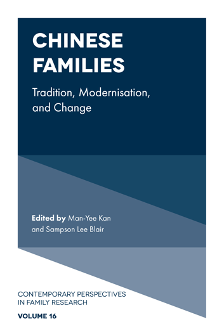
Index
Chinese Families: Tradition, Modernisation, and Change
ISBN: 978-1-80071-157-0, eISBN: 978-1-80071-156-3
ISSN: 1530-3535
Publication date: 25 January 2021
Citation
(2021), "Index", Kan, M.-Y. and Blair, S.L. (Ed.) Chinese Families: Tradition, Modernisation, and Change (Contemporary Perspectives in Family Research, Vol. 16), Emerald Publishing Limited, Leeds, pp. 237-244. https://doi.org/10.1108/S1530-353520210000016012
Publisher
:Emerald Publishing Limited
Copyright © 2021 Emerald Publishing Limited
INDEX
Index
Note: Page numbers followed by “n” indicate endnotes.
- Prelims
- Chapter 1: Changes in the Association between Education and Cohabitation in Post-reform China
- Chapter 2: Like Mother, Like Daughter? Mother–Daughter Educational Mobility in Rural China
- Chapter 3: Satisfaction with Family Status and Housework Participation in Modern China
- Chapter 4: Satisfaction of Division of Household Labour in China
- Chapter 5: Couple Similarity and Life Satisfaction: A Study of Young Couples in Shanghai of Mainland China
- Chapter 6: Gender Egalitarianism and Subjective Well-being among Older Adults in China
- Chapter 7: Housework Participation and Fertility Intentions: Analysing the Gendered Division of Labour and Fertility in Taiwan
- Chapter 8: Multigenerational Experiences of Women in Taiwanese Families
- Chapter 9: The Policy Measures Used by the Hong Kong Government to Respond to the Adult Worker Model and the Male-breadwinner Model
- Chapter 10: Attitudes Towards Marriage among Chinese and American College Students: A Comparative Study
- Index